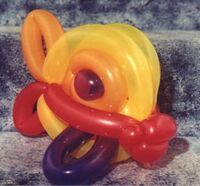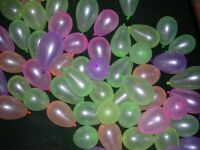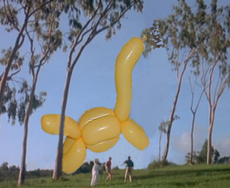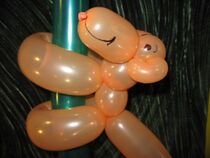Balloon Animals
When one thinks of a balloon animal (scientifically known as Animalus Blownupicus), one is immediately brought to the thought of a happy place, one where there is a festival and maybe a clown. They think about a time when they were younger, and entranced by the color of these air-filled wonders. Perhaps they were brought back to the days of cotton candy-eating and winning goldfish at a carnival game to take home and flush down the toilet. What people don't think about, though, is a long history of balloon animal evolution, as they have flourished alongside beings since the dawn of time. The balloon animal's love of reproduction and adaptability has allowed them to survive even the harshest events the globe has sent them.
The First Balloons
Before the days of the Babloon, balloon turtle, and even the Bloon-Rex, there were many little minute balloons that were smaller than the eye could see. Being very tiny, they were filled with just a molecule of water. At this point in time, creatures had still yet to develop into air-filled beings. They would swim in the water where they would rarely pop, unless they brushed up against a sharp plant, as plants were starting to evolve. When they did, they didn't die, but would be left in several pieces of rubber, or fragments. Fragmentation would then occur. This is where the bits of rubber would regrow back into a sphere, encompassing another water molecule in the process and becoming several different beings. In this condition, they would never die, and pissed the plants off.
Then multi-cellular organisms grew in the form of trilobloons. These were advanced compared to other organisms of their time. The difference was elemental: instead of holding one molecule of water, they held three, but still hadn't made it onto land yet. They were important because they were the first to have sexual intercourse. Next balloon fish were made and they would have even more molecules of water and were rather large. They had many features modern balloon fish have today!
This is where it gets tricky. Sometimes, when a balloonfish started encompassing water molecules, it would encompass some air too because the eggs sometimes washed to the shore line. When this happened, they could slightly come out of the water. Their lives were often short because the rubber often times wasn't strong enough, and they popped from too much exposure to the sun. Luckily, one day, two found each other and did the dirty deed, and now we have our amphibialoons and reptloons.
Age of the Bloonosaurs
One of the most popular eras in history is the one in which dinosaurs lived. The Jurplastic Era is very popular in modern day society, especially because of movies such as Jurplastic Park. One of the main reasons this era was so cool is because it was the Age of Reptiloons. They dominated the creatures, and the king of all was the Bloon-Rex. These creatures were filled completely with air instead of partially with water, like amphibians. Some features Bloonosaurs had were tougher rubber, in order to prevent popping from other creatures; sharp blades in their mouth, used to pop other balloons; and tails, which were used to keep them from floating away.
Eating patterns were very interesting in this era. First, there were the airbivores, which would consume the air of the world around them to increase in size. Their stomachs could handle air from the area around them. However, they lacked blades in their mouth, unlike blade-mouthed carnivores. A carnivore would simply pop an airbivore and breathe in the air it released. This way, it would increase its size without taking air from the atmosphere.
So if they were so great, what happened to these beasts? Well, there are many theories. One is that the air got tainted with a mixture of volcanic residue and too many smelly Bloon-Rex farts, causing the airbivores to become infected and die out. The carnivores would then have nothing to eat, and then die themselves. Some believe that a bunch of needles rained down from the sky and popped all the large bloonosaurs, leaving them extinct, but only few believe this because no traces of needles can be found in archeological digs. Others believe mosquitoes killed too many bloonosaurs when they tried to stick their nose into them to get blood. Although this wouldn't kill them, they would slowly deflate, and therefore die slowly and painfully.
Birdoons
But balloon animal life went on after the mass popping of bloonosaurs. New balloons were made that resembled the bloonosaurs very closely. Birdoons had a skeletal system very similar to that of their prehistoric ancestors. A major difference between the large reptloons and birdoons is that instead of being filled with air, or water like the balloon fish, they were filled with helium.
This had many advantages and disadvantages. One major advance was the ability to float in air, or fly away, depending on the helium concentration. This allowed the creatures to avoid solid objects on the ground which would make them pop. But to increase the ability to fly, they were made out of a really thin kind of rubber, and therefore were prone to popping easier.
The lifestyle was also quite different from other creatures. First, when a baby bird is born, it is filled with only air. This doesn't allow them to fly. The mother will transfer some of her helium every day for about a month to her children, and eventually, when they have enough helium, the young will be able to fly out of their nest. During flight, the birdoons will inhale and exhale oxygen to increase and decrease their helium concentration, allowing them to ascend and descend. mooooo the cow says mooo
Mamloons
Finally, biologic processes reached the point where we are now. Evolution has left us with a semi-tough-skinned air-filled creature called mamloons. There are many different shapes and colors to these mamloons and they are varied in eating habits, size, and features. Babloons were made and soon after, Balloomans appeared. Balloomans are the wisest of all creatures, and therefore have many interesting aspects.
Balloonmans have developed to the point where they can create sophisticated balloon tools. They blow up their own balloons and use them to do tasks which are otherwise hard to do. They have created little pointy balloons to pop others, tougher balloons to break stuff, and sharp balloons to cut things. This advancement is very impressive and has taken them far. They have filled some of their balloons with water and made them large so that they could go in them and see how life underwater is. They have filled some large ones with helium so that they could model the birds by developing aircraft. Sadly, "popping" a balloon woman's cherry is often times fatal.
| Featured version: 15 June 2009 | |
| This article has been featured on the main page. — You can vote for or nominate your favourite articles at Uncyclopedia:VFH. | |





